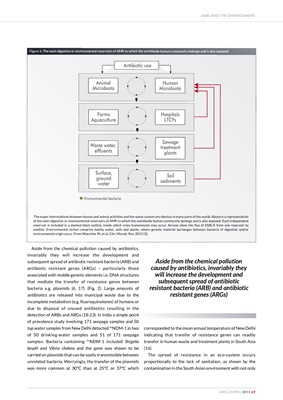
Aside from the chemical pollution caused by antibiotics,
invariably they will increase the development and
subsequent spread of antibiotic resistant bacteria (ARB) and
antibiotic resistant genes (ARGs) - particularly those
associated with mobile genetic elements i.e. DNA structures
that mediate the transfer of resistance genes between
bacteria e.g. plasmids (6, 17). (Fig. 2). Large amounts of
antibiotics are released into municipal waste due to the
incomplete metabolism (e.g. fluoroquinolones) of humans or
due to disposal of unused antibiotics resulting in the
detection of ARBs and ARGs (18-23). In India a simple point
of prevalence study involving 171 seepage samples and 50
tap water samples from New Delhi detected
bla
NDM-1 in two
of 50 drinking-water samples and 51 of 171 seepage
samples. Bacteria containing blaNDM-1 included Shigella
boydii and Vibrio cholera and the gene was shown to be
carried on plasmids that can be easily transmissible between
unrelated bacteria. Worryingly, the transfer of the plasmids
was more common at 30°C than at 25°C or 37°C which
corresponded to the mean annual temperature of New Delhi
indicating that transfer of resistance genes can readily
transfer in human waste and treatment plants in South Asia
(16).
The spread of resistance in an eco-system occurs
proportionally to the lack of sanitation, as shown by the
contamination in the South Asian environment with not only
AMR AND THE ENVIRONMENT
AMR CONTROL 2015 69
Environmental bacteria Antibiotic use
Animal
Microbiota
Farms
Aquaculture
Waste water,
effluents
Surface,
ground
water
Human
Microbiota
Hospitals
LTCFs
Sewage
treatment
plants
Soil
sediments
Figure 1: The main digestive or environmental reservoirs of AMR to which the worldwide human community belongs and is also exposed
The major interrelations between human and animal activities and the water system are obvious in many parts of the world. Above is a representation
of the main digestive or environmental reservoirs of AMR to which the worldwide human community belongs and is also exposed. Each independent
reservoir is included in a dashed black outline, inside which cross-transmission may occur. Arrows show the flux of ESBL-E from one reservoir to
another. Environmental niches comprise mainly water, soils and plants, where genetic material exchanges between bacteria of digestive and/or
environmental origin occur. From Woerther PL et al. Clin. Microb. Rev. 2013 (3).
Aside from the chemical pollution
caused by antibiotics, invariably they
will increase the development and
subsequent spread of antibiotic
resistant bacteria (ARB) and antibiotic
resistant genes (ARGs)